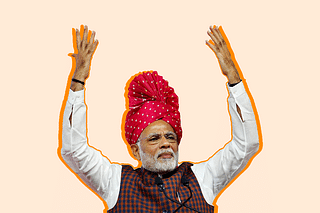Economy
Will The Digital Rupee Take Off In 2024?
Karan Kamble
Feb 29, 2024, 07:53 PM | Updated Mar 01, 2024, 01:19 PM IST
Save & read from anywhere!
Bookmark stories for easy access on any device or the Swarajya app.

Technology advances have enabled the creation of a new form of money called Central Bank Digital Currencies (CBDCs). India has been working on its own CBDC since at least 2018, with a concept note released in October 2022 and a pilot project rolled out over the next two months.
Over a year since the pilot launch, we take stock of where the project stands now. But first, here's a backgrounder on CBDCs:
We've come a long way in how we transact money — from bartering goods and exchanging physical commodities to using physical notes and coins to now mostly making electronic and/or digital payments. Initially, digital transactions occurred largely through bank account transfers, but now, increasingly, we use the sensational UPI (Unified Payments Interface) technology.
Somewhere along the way, as technology swept modern society, digital currency innovations like cryptocurrency emerged to fulfil the need for a modern, decentralised, secure, and efficient means of conducting transactions. They came through primarily as an alternative to the traditional 'fiat' currencies — the Indian rupee, United States (US) dollar, euro, Japanese yen, and British pound — which are controlled by governments and central banks.
Since cryptocurrencies like Bitcoin principally sought (and still do seek) to escape the control of governments & financial institutions like the central bank of a country, these very same authorities grew uncomfortable with them.
“There are now several new animals, or birds, whatever you call them, they are floating around under various names. Somebody calls it Stablecoins, somebody calls it cryptocurrencies,” said Shaktikanta Das, the Governor of the Reserve Bank of India (RBI), in conversation with an International Monetary Fund (IMF) official in October 2023.
“Our point of view is that let us be very careful in interpreting and understanding what consequences they have,” Das said, asking “whether governments and central banks are comfortable with private currency” and reminding that “currency is a sovereign function which the sovereign delegates to the central bank in countries like India.”
Faced with questions of consequence for financial stability and monetary order, both within a country and worldwide, India’s Das as well as governments and central bankers around the world are exploring a response to these out-of-control digital currencies. This response, they are calling a “central bank digital currency,” or CBDC, for short.
What's CBDC?
CBDCs are digital forms of a country's currency that are issued and regulated by the country's central bank — the RBI in India's case. They are like a digital version of paper money and coins, but instead of physically holding them, people can use them electronically, such as through a mobile app or a digital wallet. They would appear as liability on a central bank’s balance sheet.
The digital currency is typically built using blockchain technology, and specifically the distributed ledger technology method. Blockchain is a digital ledger technology that allows transactions to be recorded and verified across a network of computers, thereby providing security, transparency, and efficiency in recording transactions.
Hearing a word like “blockchain,” it might be easy to mix up the new-age 'digital' currencies, but here's how to tell them apart: CBDCs are different from cryptocurrencies like Bitcoin in that they are issued and backed by the central bank, making them a more stable form of digital currency.
In a way, CBDC brings us back around to the safe harbour of paper currency, which carries the message “I promise to pay the bearer the sum of…” as well as the signature of the RBI Governor as a guarantee against the banknote.
Our regular digital transactions such as through the UPI are different in that they are essentially transactions occurring with the help of intermediaries in the form of banks. With CBDC, the digital money present in one’s digital wallet is transferred to the wallet of another individual or entity, just like handing over physical cash.
Put simply, UPI is a payment system, while CBDC is a currency. The good news is that both are interoperable.
Such is the optimism surrounding CBDCs that, according to Das, they are "the future currency of the world."
The Digital Rupee
India's own CBDC is coined "e₹" or digital rupee. The RBI is seeking to create a digital rupee that's as close to paper currency as possible. "It is substantially not different from banknotes, but being digital it is likely to be easier, faster and cheaper. It also has all the transactional benefits of other forms of digital money," the RBI said in its concept note.
The prevailing approach for CBDC design leans toward a two-tier hierarchical structure utilising public-key cryptography. In this setup, the central bank acts as the root certificate authority, generating digital signatures, while other financial institutions serve as intermediate certificate authorities. An essential feature of this design is the ability to conduct secure point-to-point online payments using authorised hardware.
Key motivations for exploring CBDC issuance in India include reducing operational costs related to physical cash, promoting financial inclusion, enhancing the resilience, efficiency, and innovation of the payment system, improving settlement system efficiency, fostering innovation in cross-border payments, and offering the public benefits similar to private virtual currencies without the associated risks.
The most significant advantage of CBDCs will likely be seen in international cross-border payments. Once other countries adopt digital currencies, such payments will become much more efficient, faster, and cost-effective.
For instance, an Indian importer could pay an American exporter in real-time using digital dollars, without requiring an intermediary. Such transactions would be final, similar to handing over cash dollars, and wouldn't even need the US Federal Reserve system to be open for settlement.
Such a scenario stands in contrast to the present reality where the cost of cross-border transactions is still high, and so is the time taken for such settlements.
India is at the forefront of the CBDC pursuit alongside China, Brazil, the European Union (euro areas), and the United Kingdom (UK). More than 100 countries are exploring CBDCs presently, with the Bahamas, Jamaica, and Nigeria already having deployed CBDCs.
There are several reasons why countries are making a beeline to adopt CBDCs:
Popularising electronic currency: Central banks, facing reduced usage of paper currency, aim to promote a more widely accepted electronic form of currency.
Efficient issuance: Countries with significant physical cash use aim to streamline the issuance process by introducing CBDCs.
Meeting public demand: Central banks aim to fulfil the public's increasing demand for digital currencies, which is evident in the rising use of private virtual currencies. This move also helps mitigate potential risks associated with private currencies, which don’t have the regulatory approval of governments or central banks.
India’s CBDC Trials
India commenced limited pilot launches of e₹ for specific use cases in 2022 as a learning process — the wholesale CBDC pilot kicked off in November and the retail pilot followed a month later, in December.
That is the broad categorisation of CBDCs: retail (CBDC-R) and wholesale (CBDC-W). Retail CBDCs are for general use by the public, including businesses, while wholesale CBDCs are limited to financial institutions for settling large transactions between banks.
Retail CBDCs function like electronic cash, offering a safe payment option backed by the central bank. Wholesale CBDCs, on the other hand, aim to enhance the efficiency and security of interbank transactions.
Further, CBDCs can be token-based or account-based. In a token-based system, ownership is determined by whoever holds the token, similar to physical cash. An account-based system, however, records balances and transactions for each holder, indicating ownership.
Token-based CBDCs are preferred for CBDC-R as they resemble physical cash, while account-based CBDCs may be more suitable for CBDC-W use.
In India’s CBDC-R pilot stage, approximately 40 lakh users and 4 lakh merchants have been onboarded. In the CBDC-W mode, transactions related to the government securities market, primary auctions, government's secondary market operations, and overnight money market transactions are conducted.
CBDC hit a milestone in the last week of December 2023 by exceeding 10 lakh transactions per day.
The CBDC-R pilot currently allows for person-to-person and person-to-merchant transactions using digital rupee wallets provided by pilot banks. There is a proposal to add programmability and offline capability to CBDC retail payments.
Programmability would let entities like government agencies ensure payments for specific benefits, and corporates could programme certain expenses such as business travel.
Offline capability would enable these transactions in areas with poor or limited internet connectivity. Various offline solutions are set to be tested in hilly, rural, and urban areas. New features will be gradually introduced as the pilot project evolves to cover more locations and banks.
While India, therefore, moves decisively on CBDC implementation, the country is in no “undue hurry or rush” to roll it out nationwide. This is because, according to Das, “it is a currency, and its safety, integrity and efficiency have to be ensured.”
“Countrywide launching will depend on the success, learnings and fine-tuning of the CBDC itself,” Das said at the World Economic Forum Annual Meetings 2024 at Davos in January 2024.
Whenever it’s ready, one can expect, as Das himself does, India’s CBDC — e₹ or the digital rupee — to be a global trendsetter.
Save & read from anywhere!
Bookmark stories for easy access on any device or the Swarajya app.
Karan Kamble writes on science and technology. He occasionally wears the hat of a video anchor for Swarajya's online video programmes.
Introducing ElectionsHQ + 50 Ground Reports Project
The 2024 elections might seem easy to guess, but there are some important questions that shouldn't be missed.
Do freebies still sway voters? Do people prioritise infrastructure when voting? How will Punjab vote?
The answers to these questions provide great insights into where we, as a country, are headed in the years to come.
Swarajya is starting a project with an aim to do 50 solid ground stories and a smart commentary service on WhatsApp, a one-of-a-kind. We'd love your support during this election season.
Click below to contribute.





